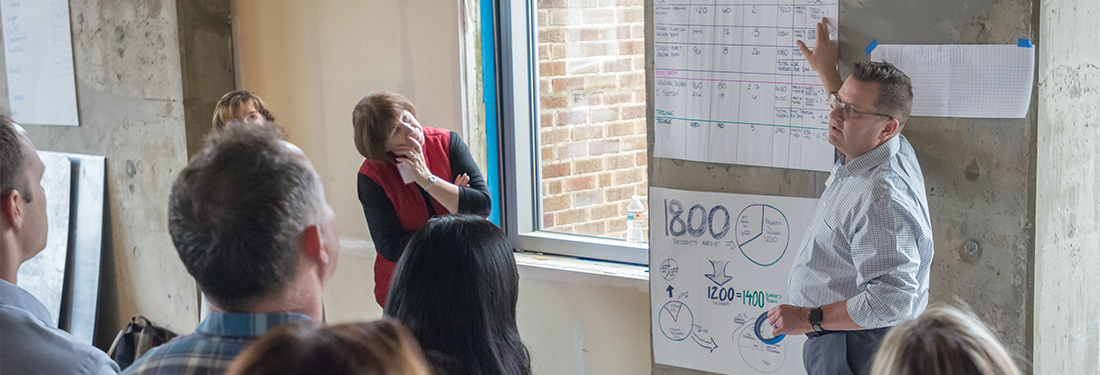How Can Andons Improve Patient Safety?
An andon — introduced by Toyota and used with great success in manufacturing, health care, retail and other industries—is a tool that signals a person or a team that there’s an abnormality or defect in a process. It can be a visual cue, an auditory cue or a process. It’s one way to gain immediate awareness of a problem and fix it in real time.
Preventing defects from reaching the patient
At Toyota, the original andon was a cord that any employee could pull to signal that he or she had found a defect in an automobile. When an employee pulled the andon, the manufacturing line slowed and a manager rushed to the employee to investigate the defect together and fix it in real time. If they couldn’t fix it in a specified length of time, the manager stopped the line completely, and other employees rushed to collaborate as a team and fix the problem. This process not only prevented a defect from reaching the customer but instigated a process to prevent the same defects from being repeated. Today Toyota’s andon is a button instead of a cord, but the culture that empowers all employees to use it remains the same.
At Virginia Mason, we use andons throughout the organization to help us prevent defects before they affect a patient. They alert us to abnormalities in a process, a need for resources, status changes and equipment availability. They also support compliance with Joint Commission standards, National Patient Safety Goals and the IOM’s Crossing the Quality Chasm report’s rules and focus on transparency.
Different types of andons
Examples of our visual andons, the most common, include lights on Code Blue carts to indicate they need to be checked for the day and intrusive computer screen alerts for pharmacists that indicate a patient allergy or contraindicated medication. A more complex andon is the VTE Clinical Andon Board, which is visible to employees, patients and families in the acute care units and signals that preventive measures need to be taken with specific patients to prevent hospital-acquired venous thromboembolism.
Examples of auditory andons are the beeping alarms on our infusion pumps that signal that a medication is nearly gone or there is defect with tubing and the audible alarms indicating acute medical emergencies such as patient falls, stroke and sepsis.
The best example of a process andon is our Patient Safety Alert System™, inspired by Toyota’s process, which enables any employee to send an alert — in person, by phone or through a website form — whenever there’s an object, person or process that could potentially cause harm to a patient. Creating this process and sustaining it wasn’t quick or easy; it required a radical shift in our culture, and we had to learn to blame processes, and not people, to convince employees to trust the system and always act in our patients’ best interests. Today, more than ten years after its implementation, our leadership team and our safety and quality experts take action and seek resolution and prevention by continually applying the Plan-Do-Study-Act (PDSA) model to be sure all employees are not only vigilant about safety but also feel empowered to use the PSA andon at any moment to keep patients safe.
“The most important aspect of an andon is not the light, the sound or the tool — it’s the response to the andon.”
– Megan McIntyre
How to best implement an effective andon
The most important aspect of an andon is not the light, the sound or the tool — it’s the response to the andon. An organization can’t simply put an andon in place and expect it to work. At Virginia Mason we use six steps to implement and sustain an andon that produces the response we need to protect patients:
- Define the goals. Be sure the team members understand why they are creating the new process or alert and are clear about the result they want.
- Determine potential problems and establish the checkpoints.
- Determine the type and method of andon. Decide whether it should be a visual, auditory or process andon — or even a combination. For example, our andon for Code Blue emergencies is both an auditory alert (a loud alarm and page) and a visual alert (flashing light or staff member directing to a location) to be sure that the appropriate people in and out of the patient’s immediate vicinity are alerted to respond.
- Develop standardized responses to the andon. Brainstorm, define and get consensus on the processes you’ll use.
- Implement the andon and the responses. Training is key to be sure that each agreed-upon response best protects the patient. In the Code Blue response we have routine scheduled drills to practice responses and train.
- Evaluate the effectiveness by using the PDSA process. Be ready to use root-cause analysis and discover ways to fine-tune the process and make it better. Andons are frequently reevaluated for effectiveness, continued need or refinement.
Some final words on andons
For an andon to be reliable and meet an organization’s goals, all team members need to know exactly what to do at the moment the andon alerts them. This takes an alignment of individual goals to team goals and organizational goals — all of which need to include patient safety at the top of the list.






